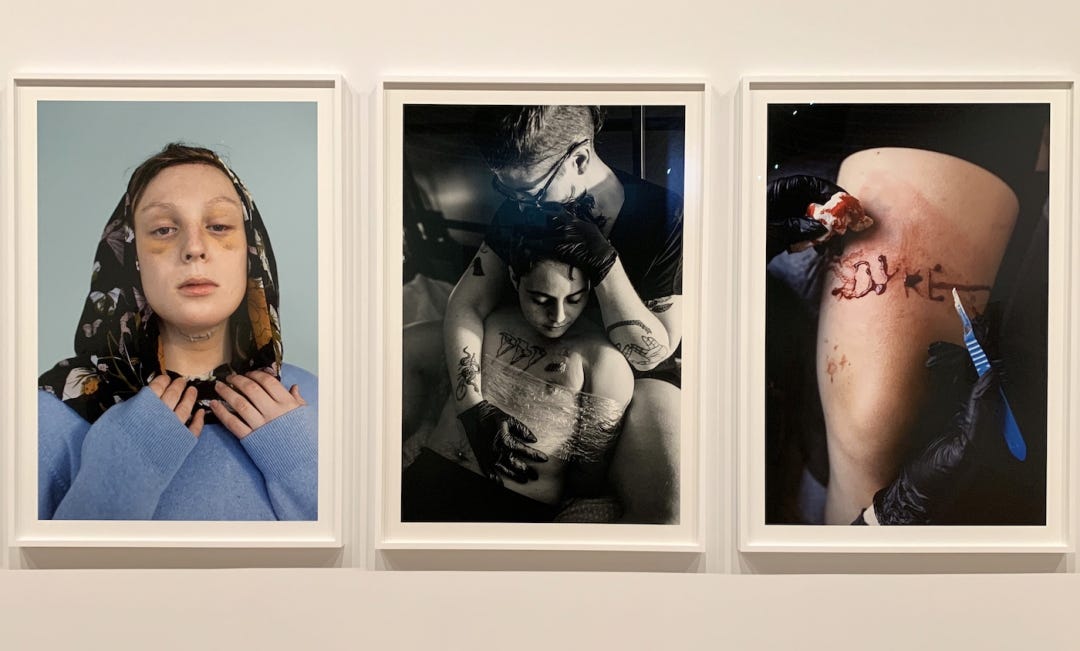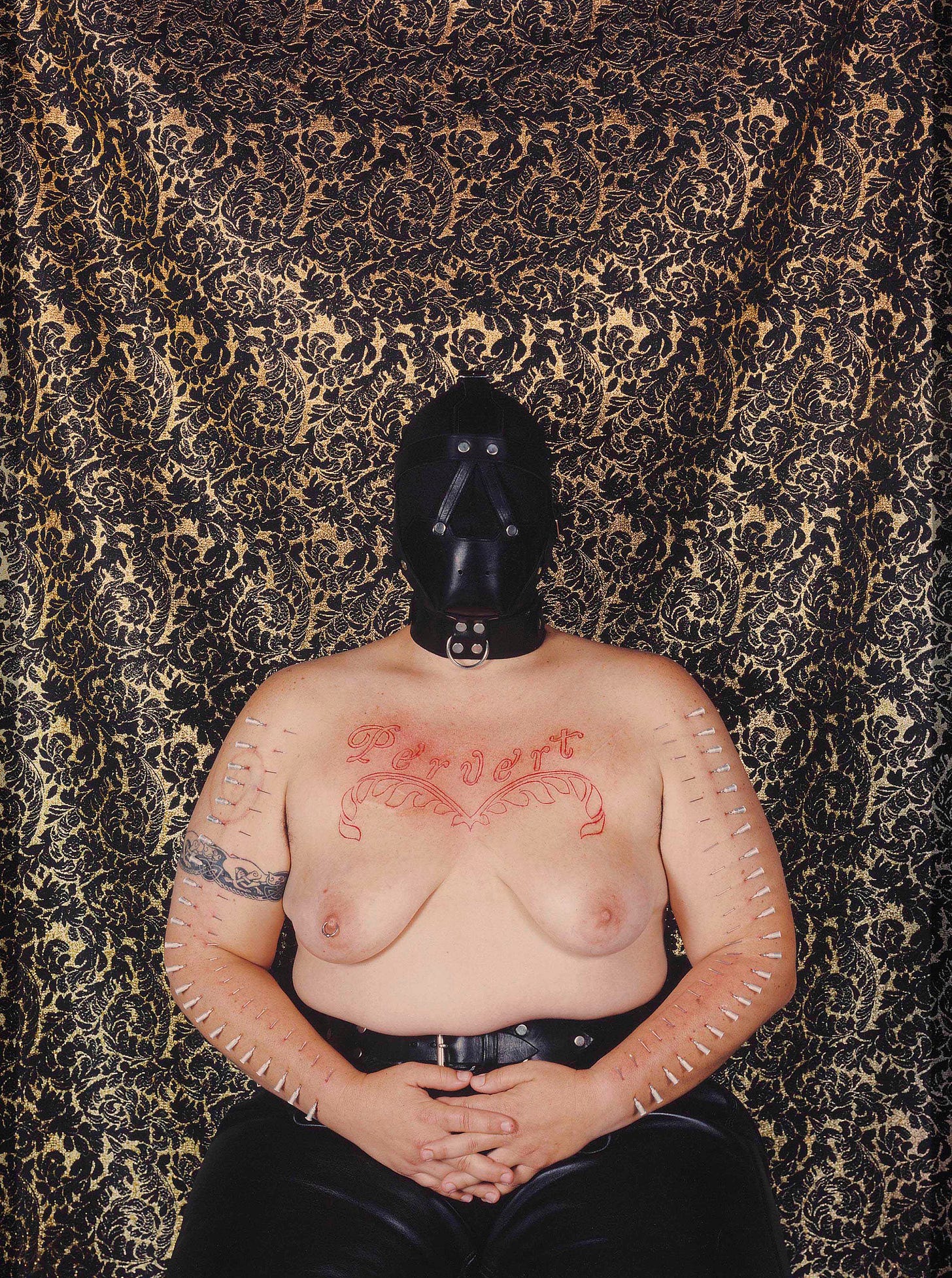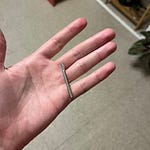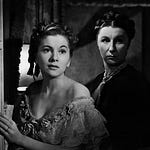I met photographer Elle Pérez the same way I meet most of my friends: on a dating/hookup app.
Two years ago, I went sadist-hunting on the now-defunct Herstory Personals, where I mentioned one of my scars1. Among my responses was a DM from a photographer who wanted to take a picture of the word spelled out in white, floss-thin lines on my left thigh.
I told Elle I would do them one better. My friend Dahlia, who had given me the scar, was going to go over it a second time—did they want to join us in exchange for some of their ~professional photos? Thanks to the systemic repression of sex workers, including pro-dommes like Dahlia, these photos couldn’t be used to advertise on sites like Eros, with their draconian TOS2, but our family loves to document our scenes3. Also, we tend to be a little exhibitionist about spilling blood.
Elle was into it. We didn’t learn until later that they were kind of a big deal, and that one of our photos was going to be included in the 2019 Whitney Biennial. It was a funny turn of events, knowing where the scar had come from. Dahlia broke virgin flesh at her old house in the Rockridge neighborhood of North Oakland in 2018, using a scalpel to slice me open, then wrapping my thigh in plastic and hammering it with her fists and other things. High on endorphins, we laughed like hyenas. I biked home ten miles with the wound shrink-wrapped like a slab of chuck steak.
Following the Biennial, I kept an eye on the coverage of Elle’s work. Most reviews misgendered Elle, misnamed our photo (the official title is “Dahlia and David [fag with a scar that says dyke]”), or found other ways to misrepresent the trans artist and their queer, and often trans, subjects. One of the reviews referred to another trans subject’s facial feminization surgery as “adam’s apple surgery”. One or two took hamfisted issue with our “conflation” of queerness and pain.
I suppose it was silly of me to expect that an artist operating at Elle’s level of institutional recognition—even as a trans person of color—might be less misunderstood. The frequency with which Elle’s work was, at best, benevolently dismissed as an “exploration” of undefined “issues of gender and cultural identity”4 was an enlightening experience for me.
As a writer, I’m challenged and disoriented by the task of communicating via image rather than text. Writers must hold the uncomfortable desire to seek total precision of language while knowing that it can never be attained5. Maybe that’s just me. In any case, in collaborating with Dahlia and Elle, it feels as if there’s another, complicating step between our expression and our audience. This isn’t a complaint about collaboration or photography or even visual media, but an observation about the differences between Elle’s art and mine.
And as a writer, I’m accustomed to being misunderstood, accusations regarding my desire to rape people in response to my genital preference series being a great case in point. I’ve often repented for writing the wrong thing, or writing the right thing wrong, though not as often as I’ve been indignant at someone else’s obtuseness. Only rarely have I had the opportunity of hindsight regarding an artistic project that wasn’t words that I wrote. Working with Dahlia and Elle and then seeing a wider-scale response than I am accustomed to was a chance to do just that. Which is to say that while I do think trans sadomasochistic art made by a trans Puerto-Rican American photographer is more likely to get short shrift—even when the artist is as undeniably “successful” as Elle is—I have spent some time thinking about the artistic choices that Dahlia and I made in the context of this general misunderstanding.
For example, though we are more or less fluid-bonded (😋), Dahlia and I decided that she would wear gloves for the shoot in order to model responsible cutting and blood play. So much of public play, or rather, social media depictions of play, doesn’t include behind-the-scenes information, guidance on safety protocols, or context about the players and their relationships. Though I’m not a sex or leather educator (Dahlia sometimes is), both of us wanted to offer a corrective for what we see as unsafe SM practices, both material and psychological, that are widely shared by inexperienced players and stand and modelers alike. In encountering abusers in and around our own communities, who we felt were enabled by this ignorance of and entitlement regarding dangerous, intimate, and high-octane activities formerly safeguarded (or as some dumbasses might put it today, gatekept) by kink and leather communities, we felt it was more responsible to show what “real” SM could look like than to indulge in the fantasy of unnegotiated sadomasochism.
This is a choice that I regret. For one, while I don’t think there’s anything wrong with “responsible” depictions of SM, that was not our purpose for the scene. The photo followed the scene; it was not a workshop, but a work of art and intimacy taking place between me and someone in my leather family. What’s more, I think the photo could have been very beautiful and interesting with Dahlia’s long, dangerous, gorgeous acrylics, which she does herself. As markers of queer, femme, and working-class whoreness, they are a key component of Dahlia’s gender identity and performance. What’s more, they are horny! Would their inclusion have helped viewers to understand the horniness of our image, which was rarely commented upon, or so it seems to me, as well as their relevance to “gender and cultural identity”? I think so.
This is not to say that depictions of safe leathersex do not have their own political purposes and ramifications, but in this instance a single pair of gloves concealed gay femme worker aesthetics that in retrospect I think should have been included in Elle’s photo, particularly in the context of the politically fraught 2019 Biennial. In the months preceding the exhibition, controversy erupted around the Whitney’s vice-chairman Warren B. Kanders, whose company is a major manufacturer of tear gas and arms. There were petitions, actions, and performances protesting this connection, as well as readings of exhibitors’ work within the framework of the Institution and capital. “While [their] images are not outrightly political in the same way Forensic Arcitecture’s formidable Triple-Chaser is, Pérez lenses bodies in uncomfortable states not always visible and accepted in mainstream narratives: bleeding, hurting, bruised, changing, and trans bodies are cast in a radically poetic light in this vital study,” wrote Kathryn O’Regan for Sleek Mag.
Without reading what Dahlia and I have to write about it, no one can look at Elle’s photo and have anything other than guesses as to why I wanted this scar, and why Dahlia wanted to give it. It’s like Catherine Opie, they say, and move on. A valid critique, I suppose, but then again I’m more interested in the relationship between body modification, identity, and connection than most.
“A photo is still a fraught metric in this post-truth moment,” writes Zoé Samudzi in her recent essay on pandemic photography and the visual nature of disease. “Art does not cover—it reveals,” wrote John Berger in his first novel, A Painter of Our Time.
We do not like to be misunderstood, especially when we are being seen in such an intimate way. All the same, I’m fascinated by critics’ reinterpretations of our play, even the ones that strike me as reductive or false. What does it mean that our scene is seen as primarily about sexuality or gender rather than BDSM, kink, love, and kinship? Or primarily about facile understandings of BDSM rather than about gender? Or primarily as torture porn rather than as softness, care, and laughter6? All recastings of our play as essentially any one thing are telling, if nothing else.
David tweets at @k8bushofficial.
Subscribe to support our mutual aid project, GOOD ADVICE/BAD GAY, a bimonthly advice series from an anonymous gay therapist who’s not afraid to hurt your feelings with the truth. Sample an unlocked post for a taste of what you’re missing.
I’ve found that mentioning more intense kinks, even if I’m not looking to fulfill them specifically, helps to weed out the inevitable fake tops.
Imagine trying to market yourself as a provider of erotic BDSM services without being able to use words that are sexual or perverted! Just imagine!
Elle has spoken about “creating archives for the future,” a project that my leather family and I share.
Of course, Elle gets it. “Intimacy intrigues me with its mysteries,” the artist has said. “The ties between my gender identity, kink, sexuality, pleasure, and pain are all interwoven. Instead of attempting to untangle them, I work within these complexities.”
Not that this desire shouldn’t be unpacked…
Any artistic critique of pain that’s unable to account for consent, particularly when there’s so much interesting scholarship being done around subjectivity and suffering, is not worth the paper it’s probably not printed on.













